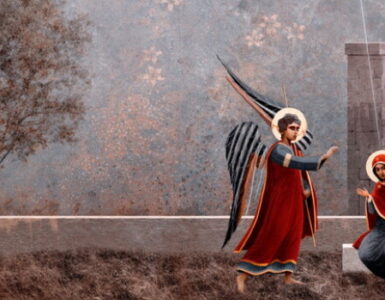In this age of identity politics, cancel culture, and the inversion of the hierarchy of true values, we may discover the root of our decline to be the endemic disorder of poor judgement preceded and followed by the rejection of first principles. Several public institutions work in concert to advance the civic campaign to blind us to the Prophet’s dire warning in Isaiah 5:20: “woe to those who call evil good and good evil.” This chilling admonition epitomizes the potential rotten fruit of poor judgement. The public propagation and proliferation of disordered conviction may be a tolerable standard for the world, but it is wholly unacceptable in the Barque of St. Peter.
Public schools are the front line of the purveyors of a bizarre judgmentalism that asserts the self-contradictory principle that we ought not to judge. To advance the agenda, the mind molders have extracted and isolated one of our Lord’s phrases from the Holy Scriptures: “judge not that you be not judged.” The irony is lost on ill-formed minds. The claim that we ought not to judge requires judgement.
To add to our difficulty, society has conditioned itself for generations to subordinate the right use of reason to the passions. Emotivism is a hidden root in the precipitous decline in societal prudence. Add to that a rejection of authority and nature and we have an epidemic of flawed judgement. It is of even greater concern that this decay has entered the sanctuaries of Holy Mother Church, including our beloved Catholic schools. Unfortunately, Catholic schools are nearly as beleaguered as their secular counterparts, with a few notable exceptions.
Still, contrary to public fiat, we are in fact called to judge, but to judge correctly. Christ’s exhortations on judgement do not begin and end in the ceaselessly repeated “judge not…” The real meaning of Christ’s words on Judgement are cautionary, not prohibitive.
Right Judgement
Reintegrating Christ’s words into His Sermon on the Mount in Matthew 7:1-3, we read,
“Judge not, that you be not judged. For with the judgment you pronounce you will be judged, and the measure you give will be the measure you get. Why do you see the speck that is in your brother’s eye, but do not notice the log that is in your own eye?”
St. John Chrysostom interprets for us that Christ “does not forbid us to judge all sin absolutely but lays this prohibition on such as are themselves full of great evils, and judge others for very small evils.” In other words, this warning is against hypocrisy and bad judgement, not judgement as such.
Further, Christ tells us in John 7:24, “do not judge by appearances, but judge with right judgment.” We were made to judge. Judgment is the second act of the mind and constitutive of an aspect of God’s image reflected in us as we were made. Unfortunately, because of the Fall, it is difficult to judge correctly. As St. Paul said, “we see through a glass darkly.” We are prone to judge by appearances and thus we judge inadequately. The exhortation to proper judgement is in the Old Testament as well.
In 1 Samuel 16:7, as Samuel seeks out a king in the house of Jesse, he stands impressed before Jesse’s older son who has the bearing of a king. But the Lord said to him “do not look on his appearance or on the height of his stature, because I have rejected him; for the Lord sees not as man sees; man looks on the outward appearance, but the Lord looks on the heart.” Samuel is cautioned, as Christ cautions us, to not judge by appearances. We are exhorted to see through to the heart of the matter and judge by the interiority of things.
The Difficulty of Proper Judgement
Proper judgement is difficult in all ages. Plato articulated the problem with his Allegory of the Cave, where he demonstrated the perennial human tendency to mistake shadows for real things. Proper judgement, as an intellectual activity, necessitates reading the interiority. In fact, the etymological roots of “intellect” come from the two concepts of reading and interiority. Proper judgement requires the intellectual capacity “to read the interiority of things.” The modern attack on correct judgement can be grasped through George Bernanos’ observation that “you understand absolutely nothing about modern civilization, unless you first admit that it is a universal conspiracy against all interior life.” This conspiracy explains the modern denial of the interior nature of things and points to the rejection of transcendent authority.
Even though the modern world denies interiority by the rejection of formal and final causality, we Catholics are potentially aided in recovering the intelligibility of the interior life by revelation, grace, and other gifts of the Holy Spirit. If we cooperate with grace, we are gifted the means by which we can return to an apprehension of the real in full. With all this in mind, let us examine one aspect of proper judgement: how to judge an institution.
Primarily, we must judge an institution by an examination of its principles and core values as we measure them against the objective standards of the transcendental good and true. In a secondary sense, we can evaluate an institution by examining certain souls who faithfully live out its principles. In the case of the Holy Roman Catholic Church, we must judge Her first by The Magisterium; Her Doctrine and Dogma. Second, we can look to the saints to deepen our understanding.
It should be obvious that the world does not judge institutions properly, especially in how it judges Holy Mother Church. As Fulton Sheen quipped “There are not one hundred people in the United States who hate The Catholic Church, but there are millions who hate what they wrongly perceive the Catholic Church to be.” Of the countless distortions of Catholic teaching, we may have all heard the false indictment “Catholics worship Mary and the saints.” This is misleading and untrue, so judgement based on it is erroneous. Worse still, is that many judge the Church by examining the lives of great sinners who claim to be Catholic. To make judgements on these false grounds are not only serious errors, but they are also intellectually and morally dishonest.
Judging Veritatis Splendor
There has been recent public commentary about a newly formed institution called Veritatis Splendor. An endeavor as bold as Veritatis Splendor is worthy of much speculation and even deserving of honest criticism and praise where truth and justice are served. Most of the public commentary on Veritatis Splendor has been descriptive, material, and speculative. Conspicuously absent from the public square is the kind of judgement articulated above.
To recover what is missing and to exercise sound judgement, let’s examine the principles of Veritatis Splendor through its stated mission, vision and core values:
Mission:
- 1. “To protect, preserve, and proclaim the truths of the Christian Faith, as given to the Apostles by Jesus Christ.”
Vision:
- 2 . “Veritatis Splendor is a physical and spiritual home for Christians to protect, preserve, and proclaim all of the chief truths and teachings of Christendom.”
- 3. “It is a community of true believers who work and live together to safeguard the deposit of faith through an uncompromising fidelity to Sacred Scripture and Sacred Tradition.”
- 4. “Veritatis Splendor includes a grand oratory and seven institutes of truth professing authenticity to liberal education, law, liberty, human rights, life, media and culture.
- 5. “Directors of the Institutes live and work in the community and, by virtue of the offices they hold, become missionaries in the world to transmit these values in a way that promotes truth, goodness, and beauty and, in so doing, restores Christ in civilization.”
Core Values:
- Truth
- Obedience
- Charity
- Hope
- Joy
- Community
The mission reflects Christ’s Great Commission in Matthew 28:19-20: “Go therefore and make disciples of all nations, baptizing them in the name of the Father and of the Son and of the Holy Spirit, teaching them to observe all that I have commanded you!” In the vision, the aim is to gather up a community of souls who share a love for Christ and desire to carry out the Great Commission. The core values speak for themselves.
Honest criticism of Veritatis Splendor ought to begin with a proper assessment of the mission and vision as they are integral with the core values. The deepest intellectual work will be to discover whether these principles are in the right kind of accord with our Tradition and Teaching as we proclaim Christ crucified in the name of Holy Mother Church. If we desire to judge the institution by human souls, we will have to discover one who faithfully lives out these principles.
Responding to a Crisis
At Veritatis Splendor, one of our chief aims is to respond to the present crisis of Faith and Reason with excellent formation in the key areas of education, law, human rights, media, life, culture, and liberty. This evangelical effort is worth scrutiny. However, it is a matter of justice to refrain from judging by appearances or by mere unformed opinions, personal attacks or even idle speculations.
The world encourages us to judge inadequately. Holy Mother Church exhorts us to judge with righteous judgement. Our quest must begin by reading the interiority of things. We must read into the truth that we are called to be in this world to evangelize, but not to be of this world. Satan rules this world, and we ought to be keenly aware that the bent one “is now at work in the sons of disobedience.” (Ephesians 2:2) We must not imitate the schools, the mass media, or the politicians. As Catholics, we must exercise proper judgement as we convey truth with our words in the service of others
In Acts 13:47, the Lord explains: “I have made you a light for the Gentiles, that you may bring salvation to the ends of the earth.” It is by the light of truth that we must judge righteous judgement and that light is Christ. Let us imitate the “one through whom all things were made” as we recover His image of intelligence imprinted on our souls, reflected in our Tradition, and acquired by the right use of reason. Let us judge righteous judgement in all things, but especially in things concerning Holy Mother Church and Her holy endeavors.
✠
Photo by Tucker Good on Unsplash














